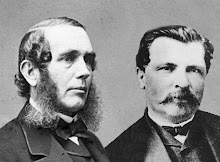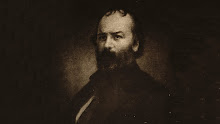The crew loved time travel so much, we decided to do it again!
It was back to Old Sturbridge Village for an Autumn shoot last week. We had hoped to get shots that echo scenes from beautiful Currier & Ives autumn prints, but alas, Mother Nature was uncooperative on a couple of fronts. First, it rained for more than half the day. Secondly, there just wasn't much foliage to shoot! They say we missed this year's pitiful peak by a few days. Still, we have some beautiful footage of indoor handwork, such as blacksmithing. The fire, the hammering, the smoke, the red-hot iron, the bellows: a cameraperson's dream! The village cooper also provided us with wonderful video and audio opportunities and we got the inside scoop on how to make a "Piggin". We didn't know what it was, either. It turns out that it's a wooden bucket used to collect scraps to toss out to the pigs.
We'll shoot at the Village two more times. Up next, a few re-enactments to be shot there later in the Fall. The folks at Old Sturbridge are conducting an informal scout for Currier & Ives lookalikes, or at least, built-alikes. We'll tape two men representing the printmakers at work together, poring over prints, and walking together, etc. It will likely be done in shadow or silhouette. I don't need actors who exactly resemble Nathaniel Currier and James Ives, but I do need them to have similar builds. That means one is slim, tall, and fair and the other is dark, short, stocky and probably younger.
In the winter at the Village, we will try recreating Currier & Ives famous "The Road-Winter" sleighride, which is arguably the firm's single most recognizable image. Of course, we'll also use Old Sturbridge Village as a backdrop for scenes reminiscent of the firm's most famous (and now, valuable) large folio winter lithographs drawn from paintings by New Haven artist, George Durrie. Let's hope Mother Nature makes up for an anemic Fall with some hearty Winter snowstorms!
On another front, we're preparing for two more Teacher Workshops at the Springfield Museums that will use its Sid and Lenore Alpert Collection of Currier & Ives prints as a springboard for developing innovative lesson plans. I'll be presenting the short video, which you can link to on the website, at November 17th's Workshop.
On November 12, Sid Alpert himself will come to Springfield for some additional shooting. You may remember that we shot an interview with Sid at his home in Maryland over the Summer. I wanted him here in Springfield to see him with his former collection and to add visual support to the story of his prints "coming home" to Massachusetts.
I apologize that this blog is a week late; I recently lost a round with the flu and I'm getting back on my feet and catching up on things!
I'll keep you posted.
Monday, October 29, 2007
Monday, October 8, 2007
Currier & Surprise
What makes a good documentary is surprising. The verb surprising, not the adjective. There is something so satisfying about sharing an astounding insight, revealing new information, or providing the lens that allows someone to see a familiar thing with fresh eyes.
When you're researching a subject that has been well covered over the course of more than a century, sources often re-tell similar stories and cite familiar facts. But once in a while, you hear something that snaps you to attention. That's why talking with Chris Lane last week was so much fun. Lane is the co-owner of The Philadelphia Print Shop and a regular contributor to PBS' Antiques Road Show.
In our interview at WGBY's studio, Chris revealed that he doesn't buy the oft-told tale that the Lexington disaster print launched Nathaniel Currier's career. He demands the statistics that back that up. He's lively on this topic and so many others because he just never accepts the conventional wisdom about Currier & Ives. His is an historian's mind, always digging deeper and challenging the easy answers. I know you'll enjoy his presence throughout the series because he combines elevated knowledge with a down-to-earth delivery.
The crew later drove to pretty Deerfield, Massachusetts to catch Chris Lane at work at an astounding Antiques Fair. Here, he showed me something I'd never noticed before: a print in which some of the faces appear to be photographically copied onto bodies. Chris is sure they are photographic images and not drawn and indeed, they do look different than other faces in the lithograph. There are other Currier & Ives pictures in which he says the same technique was used. After a little more research, I think we will look at some of those prints in the series and explore why the technique may have been used. This information was a fascinating surprise.
This week, I'll be setting up some Fall shoots at Old Sturbridge Village and the Springfield Museums and, of course, the writing continues. I'll keep you posted.
When you're researching a subject that has been well covered over the course of more than a century, sources often re-tell similar stories and cite familiar facts. But once in a while, you hear something that snaps you to attention. That's why talking with Chris Lane last week was so much fun. Lane is the co-owner of The Philadelphia Print Shop and a regular contributor to PBS' Antiques Road Show.
In our interview at WGBY's studio, Chris revealed that he doesn't buy the oft-told tale that the Lexington disaster print launched Nathaniel Currier's career. He demands the statistics that back that up. He's lively on this topic and so many others because he just never accepts the conventional wisdom about Currier & Ives. His is an historian's mind, always digging deeper and challenging the easy answers. I know you'll enjoy his presence throughout the series because he combines elevated knowledge with a down-to-earth delivery.
The crew later drove to pretty Deerfield, Massachusetts to catch Chris Lane at work at an astounding Antiques Fair. Here, he showed me something I'd never noticed before: a print in which some of the faces appear to be photographically copied onto bodies. Chris is sure they are photographic images and not drawn and indeed, they do look different than other faces in the lithograph. There are other Currier & Ives pictures in which he says the same technique was used. After a little more research, I think we will look at some of those prints in the series and explore why the technique may have been used. This information was a fascinating surprise.
This week, I'll be setting up some Fall shoots at Old Sturbridge Village and the Springfield Museums and, of course, the writing continues. I'll keep you posted.
Subscribe to:
Posts (Atom)

















